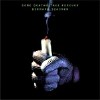 A pioneer in the use of laser technology in entertainment, Szajner's futurism carried into his other pursuits. His second album is a soundtrack to a documentary on capital punishment, but the mood feels more akin to the techno-dystopias popular in science fiction at the time of its release. Fans of Blade Runner or Escape from New York will be familiar with Szajner's aesthetic, but his dynamic songcraft sets him apart from the cinematic snyth musicians of his generation.
A pioneer in the use of laser technology in entertainment, Szajner's futurism carried into his other pursuits. His second album is a soundtrack to a documentary on capital punishment, but the mood feels more akin to the techno-dystopias popular in science fiction at the time of its release. Fans of Blade Runner or Escape from New York will be familiar with Szajner's aesthetic, but his dynamic songcraft sets him apart from the cinematic snyth musicians of his generation.
Although Szajner is somewhat of an obscure figure now, Some Deaths Take Forever was not only critically acclaimed, but influential as well. Carl Craig has stated that it is his favorite album ever. Szajner’s accolades and influential friends are impressive, but looking back his musical innovation may have been overstated. Many people were making dark, sci-fi influenced snyth-music at the time. Some Deaths take Forever doesn’t transcend the genre, but there are elements that make it stand out. Not content to let his synths play themselves, Szajner wrote fully realized compositions with an obvious beginning, middle, and end. The instrumentation is also diverse; Szajner included piano, guitar, electric piano, even a bassoon into the mix. On “Resurrector,” drum rolls combine with pearly arpegiatted tones and phased guitar until the tension boils over like a pot of spaghetti. The clever introduction of new instruments and moods keeps the songs from stagnating. Rather than being just a soundtrack, it has the complexity and self contained logic of a proper album.
As much as I enjoyed Some Deaths take Forever, it is definitely of its time, rather than ahead of it. The digital keyboard was just being introduced and its clear yet flat sound can be heard in the ersatz cello of “A Single Broken Wing” or the fake brass in “Suspended Animation.” The tone of the electric guitars sounds dated as well, the string bends and flighty solos are a bit too theatrical for a documentary about death row. Judging the album by today’s tastes isn’t entirely fair, though. After all, Szajner was working with the technology and musicians available to him at the time. He couldn’t have known that his music was going to sound retro 20+ years down the line. In any case, Szajner’s dynamic sense counterbalances the limitations of his style and instruments.
The album has enough unique moments to be enjoyed instead of relegated to a time capsule. “A Kind of Freedom” begins as a radio collage that morphs into a sad processional with jazzy Rhodes playing and synths that bob up and down in airy portamento. The bonus track, “Thol Ostia,” follows that up with dreamy minimalist ambiance anchored by marimbas and high, cybernetic whistling. These pieces are harder to categorize and they reinforce Szajner’s reputation as a lost genius of synth music. Perhaps he was not as forward looking as his supporters assumed, but his music demonstrates a technical density and driving energy that makes it exciting almost three decades later.
samples
Read More

